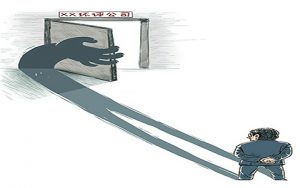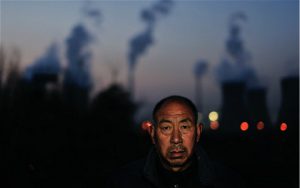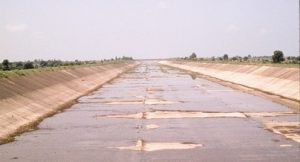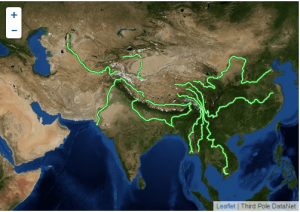In February, the Chinese Academy of Sciences’ Institute of Law concluded that environmental pollution was the main driver of public protests in China. The Ministry of Environmental Protection has also said that these protests should be treated as an important matter.
The attention being given to the issue is hardly surprising: environmental protests in China have been growing by 29% a year since 1996, according to state news agency Xinhua. 2012 was a particularly hot year, with major demonstrations seen in Shifang, Qidong, Ningbo and Kunming.
In the wake of calls for stronger rule of law at China’s 4th Plenum last month, and ahead of the introduction of China’s new environmental protection law next year, chinadialogue asked Cao Mingde, law professor at the China University of Politics and Law, for his views on the future of environmental protest in China.
Liu Qin (LQ): A lead recycling plant in Jiangxi was recently smashed up by protestors. What do you see as the root cause?
Cao Mingde (CM): Judging from the media reports, it was the way the local government planned and selected the site for the project, and problems with the environmental impact assessment, that gave rise to the protest.
The town had previously seen cases of high lead levels, even poisoning, due to lead pollution, and the residents were concerned or repulsed by the idea of another lead plant. Those concerns weren’t theoretical or imagined, but arose from historical incidents and real experiences. The local government and environmental protection bureau should have learned from those earlier cases and kept industrial and residential zones separate. Putting a heavy-metals plant just a kilometre away from people’s homes shows a lack of consideration for the feelings of residents.
There are also doubts over the environmenal impact assessment process – whether it fully revealed the effects the plant would have on the environment, and whether the attitudes and views of interested parties, particularly the residents, were heard and respected. The anger of the residents as shown in the protests reflects this.
But attacking the plant and its workers is completely illegal and there should be legal consequences. Did the protestors fully exhuast normal means of remedy, such as reporting the problem to Party and government bodies, or protecting their legal interests via an environmental protection organisation? Radical and rash actions will have no positive outcome under the rule of law. Only in a disorderly society does the law of the jungle have a role.
LQ: Meanwhile, 394 pollution victims in Fujian’s Minhou County have won a rare victory, after five years of pursuing their case through the courts. What does that verdict tell us?
CM: That rare victory gives enviromental victims fighting for their rights a little hope, and can actually be regarded as a model for future resolution of environmental protests – the “Minhou model”. The victory may look like a one-off, but could encourage others to follow.
That successful case shows that legal channels are feasible – if long and difficult to take. But that’s also true in countries where the rule of law is mature. The fact that it took five years points to some of the problems common to environmental cases: it’s hard to get a case heard, to assess damages, to win the case and to have the judgement enforced. Other lawsuits have shown that it’s common for local government to interfere, and that courts struggle to make independent judgements.
So a number of elements are needed, such as environmental NGOs, specialised lawyers, funding and skills in rights protection. The Center for Legal Assistance to Pollution Victims, an NGO based at China University of Political Science and Law, founded by professor Wang Canfa, has accumulated a lot of experience in helping victims of pollution fight the polluters. The forces promoting the environmental rule of law are getting stronger.
LQ: What is the key to resolving environmental protests?
CM: These protests grow out of environmental injustice, and the protesters are often responding to the impossibility or difficulty of resolving that injustice within the existing framework. It is a kind of social campaign, something that the West has also seen.
Environmental protests arise when interested parties, the public and organisations are not informed or given opportunity to comment on government policies, plans and rules, as would happen under the rule of law. So they cannot express their opinions and interests, and the government loses the opportunity to gather data and respond to those comments by adjusting or explaining its approach.
Decision-making at the local government level is kept within government circles – there are no legally required processes for making the drafting of policies or regulations public. That means the public are uninformed and have little respect for those decisions. In particular, the right to know, to participate, to seek judicial or administrative redress are often ignored by local officials. They convince themselves they are making the right decision for the government or the people, launching major industrial projects for wider benefit and happiness. But we cannot rely on officials to tell us if the people are content – we need to ask them. The key is to improve the capability and quality of local governance, including awareness of the rule of law, particularly in the environmental field, and amongst decision-maker and managers, in order to deal with environmental protests at the root.
Another key approach is increasing awareness of legal options among the victims of pollution. Those victims deserve sympathy, support and legal assistance. But when they advocate for their rights in inappropriate ways, they achieve the opposite to what they hope for, and may end up suffering more. The law sympathises with victims, but absolutely will not tolerate bad behaviour. The rule of law requires citizens to be able to use the law, and being able to mobilise social resources, such as the media, is often a very effective way of condemning the immoral acts of polluters. Under the rule of law we need to learn how to discuss matters in a civilised manner, not to use violence – and the victims must not wreak further harm. The “Minhou Model” is worthy of praise.
Another characteristic of the rule of law is a well-developed NGO sector, able to participate in the drafting and implementation of laws, policies and regulations. This means that process of drafting is itself a long process of back-and-forth between different interest groups.
LQ: What impact do you think the new version of the Environmental Protection Law will have on the protest numbers when comes into effect in 2015? Will it slow the growth?
CM: The focus we saw on the rule of law at this autumn’s 4th Plenum provides a rare opportunity for environmental law. Add in the new version of the Environmental Protection Law, set to come into effect next year, and we may see a turning point in numbers of environmental protests, with the start of a slower rate of increase. This is because it will be possible for victims of pollution to protect their rights through legal measures, reducing the likelihood that they take matters into their own hands.
It’s undeniable that protests often occur after those involved have found other channels blocked and put up with as much as they possibly can. The new law provides a system for those people to use, allowing the public, NGOs, supervisory bodies and the media to better combat pollution. NGOs and supervisory bodies will be able to bring lawsuits. This will reduce pollution and environmental damage, and so reduce the frequency of environmental protests.
Rule of law in the environmental field will also be a beachhead to wider rule of law. Drafting of policies, laws and rules; openness of government information; the public’s right to know and to participate; public governance, independent courts – to a large extent these are all present in the environmental field, or are promoted by environmental law. Given the seriousness of Chinese environmental damage, there is an urgent need for rule of law in this field, and it will provide an important test bed for the wider rule of law.








